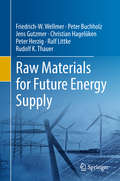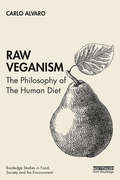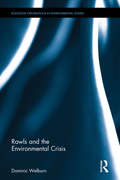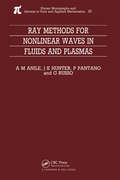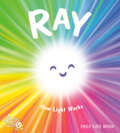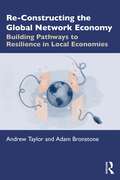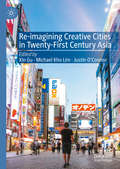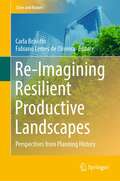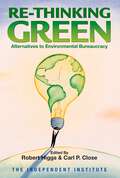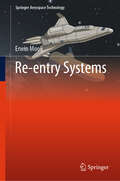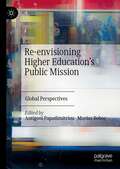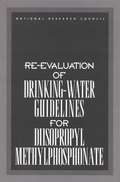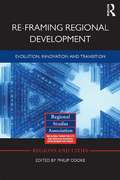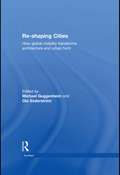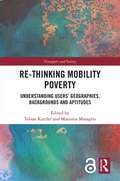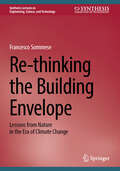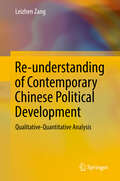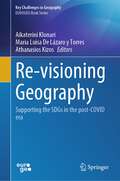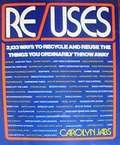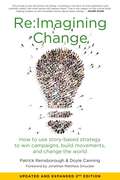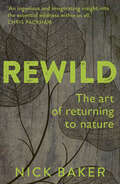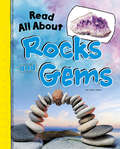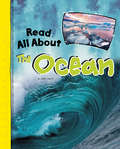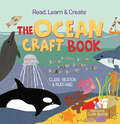- Table View
- List View
Raw Materials for Future Energy Supply
by Peter Buchholz Friedrich-W. Wellmer Jens Gutzmer Christian Hagelüken Peter Herzig Ralf Littke Rudolf K. ThauerThis is the first book that analyses the future raw materials supply from the demand side of a society that chiefly relies on renewable energies, which is of great significance for us all. It addresses primary and secondary resources and substitution, not only from technical but also socioeconomic and ethical points of view.The “Energiewende” (Energy Transition) will change our consumption of natural resources significantly. When in future our energy requirements will be covered mostly by wind, solar power and biomass, we will need less coal, oil and natural gas. However, the consumption of minerals, especially metallic resources, will increase to build wind generators, solar panels or energy storage facilities. Besides e.g. copper, nickel or cobalt, rare earth elements and other high-tech elements will be increasingly used. With regard to primary metals, Germany is 100 % import dependent; only secondary material is produced within Germany. Though sufficient geological primary resources exist worldwide, their availability on the market is crucial. The future supply of the market is dependent on the development of prices, the transparency of the market and the question of social and ethical standards in the raw materials industry, as well as the social license to operate, which especially applies to mining. The book offers a valuable resource for everyone interested in the future raw material supply of our way of life, which will involve more and more renewable energies.
Raw Veganism: The Philosophy of The Human Diet (Routledge Studies in Food, Society and the Environment)
by Carlo AlvaroHuman beings are getting fatter and sicker. As we question what we eat and why we eat it, this book argues that living well involves consuming a raw vegan diet. With eating healthfully and eating ethically being simpler said than done, this book argues that the best solution to health, environmental, and ethical problems concerning animals is raw veganism—the human diet. The human diet is what humans are naturally designed to eat, and that is, a raw vegan diet of fruit, tender leafy greens, and occasionally nuts and seeds. While veganism raises challenging questions over the ethics of consuming animal products, while also considering the environmental impact of the agriculture industry, raw veganism goes a step further and argues that consuming cooked food is also detrimental to our health and the environment. Cooking foods allows us to eat food that is not otherwise fit for human consumption and in an age that promotes eating foods in ‘moderation’ and having ‘balanced’ diets, this raises the question of why we are eating foods that should only be consumed in moderation at all, as moderation clearly implies they aren’t good for us. In addition, from an environmental perspective, the use of stoves, ovens and microwaves for cooking contributes significantly to energy consumption and cooking in general generates excessive waste of food and resources. Thus, this book maintains that living well and living a noble life, that is, good physical and moral health, requires consuming a raw vegan diet. Exploring the scientific and philosophical aspects of raw veganism, this novel book is essential reading for all interested in promoting ethical, healthful, and sustainable diets.
Rawls and the Environmental Crisis (Routledge Explorations in Environmental Studies)
by Dominic WelburnThe liberal political theorist John Rawls, despite remaining largely silent on ‘green concerns’, was writing during a time of increasing awareness that the ecological stability of the earth is being compromised by human activity. Rawls’s reluctance to engage with such concerns, however, has not stopped several scholars attempting to ‘extend’, or ‘expand’, his works to incorporate this newfound fear for the ecosystems that support human life. But why Rawls? What is to be gained from developing the ideas of a theorist whose primary aim was to establish a system of justice for contemporaneous, rational, and reasonable citizens of a liberal polity? This research monograph offers a critical consideration of the contextual framework within John Rawls’s Political Liberalism and considers its compatibility with the conceptual process of ‘greening’. Rawls and the Environmental Crisis argues that Rawls’s perceived neutrality on green concerns is representative of a widespread societal indifference to environmental degradation and describes the plurality of methodological and ethical approaches undertaken by green political theorists in analyzing the contribution Rawls’s theory makes to environmental concerns. Addressing a series of key debates within contemporary political philosophy regarding a wider frustration with liberal theory in general, Rawls and the Environmental Crisis will be of great interest to researchers in contemporary political philosophy, environmental ethics, green political theory, stewardship theory, and those interested in renewing existing conceptions of deliberative democracy.
Ray Methods for Nonlinear Waves in Fluids and Plasmas (Monographs And Surveys In Pure And Applied Mathematics Ser.)
by Marcelo Anile P Pantano G Russo J HunterPresents in a systematic and unified manner the ray method, in its various forms, for studying nonlinear wave propagation in situations of physical interest, essentially fluid dynamics and plasma physics.
Ray's Big Day: A Journey at the Speed of Light
by Josh LewisFollow one little ray of light as she embarks on an exciting journey through the solar system and beyond!When Ray launches from the sun into outer space, she knows she's destined for adventure. But who knew everything in space was so far apart? Can Ray unlock her creativity to pass the time and make something new?With a lovable protagonist and engaging comic illustrations, Ray's Big Day tackles the vastness of space through one ray of light's optimistic exploration. Ray's journey makes basic information about the solar system, the universe, and the speed of light accessible and engaging for kids. Fun and educational backmatter illustrates how far and fast light travels through our solar system.Perfect for readers of Stacy McAnulty's Earth! My First 4.54 Billion Years.
Ray: How Light Works (A Science Pals Book)
by Emily Kate MoonThe dazzling Ray illuminates how light works—part of the Science Pals series, including Drop: An Adventure through the Water Cycle and Puff: All About AirMeet Ray. He's light! And he's been shining since time began. Wherever there's life on Earth, there's Ray, helping everything under the sun thrive. And Ray can really move—fast. Have you ever hurtled through space? Become a rainbow? Made food for plants? Ray has! With brilliant wit and sparkling one-liners, Ray introduces readers to a light show like no other. Filled with awe-inspiring artwork, funny asides, and a spotlight on kid-enticing facts, Ray invites us to bask in his warmth, as he illuminates our world."[A] refreshing combination of charm and solid fact [and] a high-wattage spotlight on our most important power source." —Kirkus "[A] brilliant addition to the Science Pals series. . . . Every part of the book is packed with fascinating facts and tidbits. [Kids] will appreciate Moon's inviting approach." —Booklist
Re-Constructing the Global Network Economy: Building Pathways to Resilience in Local Economies
by Andrew Taylor Adam BronstoneThis book looks at how to build more resilience into socio-economic networks within local communities. Understanding the relationships between attachment to place, complex systems and patterns of knowledge creation is not straightforward, but these relationships are emerging as the challenges that we face in bridging the gap between the social worlds that we inhabit and an emerging digital world. These issues have been brought into even sharper focus through changes resulting from the COVID-19 pandemic. On the one hand, forced familiarity with communication technologies is driving globalisation forwards, whilst on the other, the crisis has created awareness of dependencies and heightened desires for more local solutions. Plenty of books have been written about the rise of digital networks and the decline of local communities. This book takes a radical approach by identifying how these trends fit together and provides examples of how digital networks can be made to work for the local as well as the global economy. Using a case study approach, the book offers a clear-sighted view of the role of relational capital in specific places and organisations and shows the transformational impact that they can have at a micro level. The book deliberately seeks to shake up preconceived ideas and is ideal for strategy practitioners and policy makers within governments and NGOs involved in connecting local to wider network economies.
Re-Imagining Creative Cities in Twenty-First Century Asia
by Michael Kho Lim Justin O’Connor Xin GuThis book responds to the lack of Asian representation in creative cities literature. It aims to use the creative cities paradigm as part of a wider process involving first, a rapid de-industrialisation in Asia that has left a void for new development models, resulting in a popular uptake of cultural economies in Asian cities; and second, the congruence and conflicts of traditional and modern cultural values leading to a necessary re-interpretation and re-imagination of cities as places for cultural production and cultural consumption. Focusing on the ‘Asian century’, it seeks to recognise and highlight the rapid rise of these cities and how they have stepped up to the challenge of transforming and regenerating themselves. The book aims to re-define what it means to be an Asian creative city and generate more dialogue and new debate around different urban issues.
Re-Imagining Resilient Productive Landscapes: Perspectives from Planning History (Cities and Nature)
by Fabiano Lemes de Oliveira Carla BrisottoThis book explores how lessons from past urban planning experiences can inform current debates on urban agriculture. Productive landscapes today have been posited as instruments for the positive transformation related to territorial fragility and abandonment, promoting social cohesion, food security and wider environmental and economic benefits. The book will re-map the way in which seeming landscape limitations and challenges can be turned into potential, innovation and a new lease of urban-rural life. It does so by drawing on significant past urban agricultural experiences in planning as vectors for new critical reflections relevant to re-igniting ideas for future envisioning of urban scenarios in which productive landscapes play fundamental transformative roles. The focus is on planning ideas and the roles of key individual planners, all of which have designed agricultural strategies for the city at some point in their careers. It intends to help us today reimagine urban-rural relationships, and the transformation of under or mis-used urban open spaces, peri-urban areas, fringe conditions and in-between spaces.
Re-Thinking Green: Alternatives to Environmental Bureaucracy
by Robert HiggsEnvironmental quality has been a major public concern since the first Earth Day in 1970, yet the maze of environmental laws and regulations enacted since then has fostered huge government bureaucracies better known for waste and failure than for innovation and success.Can we do better than this failed environmental bureaucracy? The noted contributors to this volume answer with a resounding "yes." Re-Thinking Green exposes the myths that have contributed to failed environmental policies and proposes bold alternatives that recognize the power of incentives and the limitations of political and regulatory processes. It addresses some of the most hotly debated environmental issues and shows how entrepreneurship and property rights can be utilized to promote environmental quality and economic growth. Re-Thinking Green will challenge readers with new paradigms for resolving environmental problems, stimulate discussion on how best to "humanize" environmental policy, and inspire policymakers to seek effective alternatives to environmental bureaucracy.
Re-entry Systems (Springer Aerospace Technology)
by Erwin MooijThis book explains and describes re-entry systems for both the Earth and other planets. It provides sufficient information for readers to perform entry mission analysis for different bodies in the Solar System. Not only does it discuss re-entry flight mechanics, but also addresses relevant subsystems and fields, enabling readers to put the information into perspective. The book begins with a complete description of planetary environments, including atmosphere, gravity fields and the shape of the primary body. After a detailed discussion of planar flight mechanics, it then moves on to discuss guidance, navigation, and control, entry, descent, and landing systems, as well as thermal protection systems. It uses examples throughout the text, enabling the theory to be linked to practical applications. Ideal for those wanting an updated, thorough discussion of re-entry systems, this book is suitable for students and researchers.
Re-envisioning Higher Education’s Public Mission: Global Perspectives
by Antigoni Papadimitriou Marius BobocThis book covers initiatives related to higher education’s public mission such as university-community engagement, knowledge transfer, economic development, and social responsibility, using empirical and conceptual cases in the US, South America, Europe, Africa, and Asia. In order to develop a better understanding of public mission initiatives in higher education across the globe, the volume editors developed a theoretical framework emerging from organizational theory. Each chapter analysis uses both external environmental elements (political, economic, sociocultural, and technological), as well as internal institutional elements (mission, vision, leadership, and governance). Finally, each chapter highlights issues related to implementation and challenges with the intent of prompting readers to consider appropriate ways in which to adopt some of the lessons learned by the contributing authors.
Re-evaluation Of Drinking-water Guidelines For Diisopropyl Methylphosphonate
by Subcommittee on the Toxicity of Diisopropyl MethylphosphonateThe National Academies Press (NAP)--publisher for the National Academies--publishes more than 200 books a year offering the most authoritative views, definitive information, and groundbreaking recommendations on a wide range of topics in science, engineering, and health. Our books are unique in that they are authored by the nation's leading experts in every scientific field.
Re-framing Regional Development: Evolution, Innovation and Transition (Regions and Cities #62)
by Philip CookeTurbulence characterises the current global scene. This book uses complementary theoretical approaches to understand and help prescribe policies to ‘re-frame’ the regional development problem in turbulent times. These approaches are: evolutionary complexity; evolutionary economic geography; emergence theory; and resilience theory. From below, they address the four major crises creating a ‘perfect storm’ for societies and economics involving: the climate change crisis; the energy crisis; the banking and financial crisis; and the global economic crisis. This book analyses and proposes ways in which regional economies, in particular, are having to be ‘reframed’ to address these crises. First, many must evolve in new ways, possibly moving back from the ‘service economy’ towards a new, greener form of manufacturing of goods as well as services. Accordingly, regional economies are innovating in new ways. Amongst these are the quest for ‘relatedness’ within their own regional orbits, and promoting ‘modularity’ as a mode of analysis and a policy stance to stimulate innovation across industry and geographical borders. Finally, regional economies and societies are discovering that, from a ‘resilience’ perspective, they must find answers to the higher levels of governance with which they increasingly struggle. In this respect regional economies are in ‘transition’ and regional processes are ‘emergent’. The transition seeks to address the four crises, involving re-balancing, re-directing and re-framing future policy and practice. This book describes many of the novel ‘framings’ involved in understanding the new ways in which this major task is being addressed in theory, policy and everyday practice.
Re-shaping Cities: How Global Mobility Transforms Architecture and Urban Form (Architext)
by Ola Söderström Michael GuggenheimThis original collection examines how architectural ideas, social models and building forms circulate round the world and become mediated and adapted to local conditions. The book shows how types such as skyscrapers, mosques or living history museums are imported, adapted and contested in different societies and how urban landscapes are reshaped by the global circulation of models drawn from elsewhere. Written by scholars from different disciplinary backgrounds –architecture, anthropology, geography, linguistics, science studies and sociology – the book draws its inspiration from a series of different approaches and offers both original theoretical reflection and carefully crafted case-studies.
Re-thinking Mobility Poverty: Understanding Users' Geographies, Backgrounds and Aptitudes (Transport and Society)
by Massimo Moraglio Tobias KuttlerThis book seeks to better conceptualise and define mobility poverty, addressing both its geographies and socio-economic landscapes. It moves beyond the analysis of ‘transport poverty’ and innovatively explores mobility inequalities and social construction of mobility disadvantages. The debate on mobility poverty is gaining momentum due to its role in triggering social exclusion and economic deprivation. In this light, this book examines the social construction of mobility poverty by delving into mobility patterns and needs as they are differently experienced by social groups in different geographical situations. It considers factors such as the role of transport regimes and their social value are considered when analyzing the social construction of individual´s mobility needs. Furthermore, the gaps between articulated and unarticulated needs are identified by observing actual travel patterns of individuals. The book offers a comparison of the global phenomenon through fieldwork conducted in six different European countries - Greece, Portugal, Italy, Luxembourg, Romania and Germany. This book will be useful reading for planners, sociologists, geographers, mobility/transport researchers, mobility advocates, policy-makers and transport practitioners.
Re-thinking the Building Envelope: Lessons from Nature in the Era of Climate Change (Synthesis Lectures on Engineering, Science, and Technology)
by Francesco SommeseThis book illustrates the potential of nature when it comes to rethinking the role of the building envelope, which is responsible for energy flows between the internal and external environment, in the era of climate change. Nature has always inspired architects and engineers in the design of structures and buildings, but its role has been limited to a simple morphological imitation with aesthetic value. Today, however, thanks to the biomimetic discipline, which imitates the functional processes of nature, it is possible to transfer nature's adaptive strategies to architecture and promote the design of buildings and architectural structures that adapt to the surrounding context and respond passively to environmental changes. The use of advanced and innovative technologies, combined with the use of smart and self-responsive materials, favours the creation of adaptive and responsive dynamic envelopes, capable of adapting their performance to the changing conditions of the environment. In this way, the envelope is no longer seen as a static element, but as dynamic and able to adapt to its context by playing an active role. After establishing a general framework for the climate adaptive building envelope and analysing the adaptation strategies of natural organisms, this book provides an overview of the biomimetic discipline applied to architecture and building technology. The analysis of emblematic and recent case studies, together with advanced techniques and materials and the illustration of biomimetic design methods, gives this text an added value that promotes the understanding of the different phases necessary to move from nature to architectural technologies. This book is an indispensable tool for researchers in the field to understand an innovative and advanced concept that meets the needs of the time. In addition, it can also help façade manufacturers to understand the current directions of scientific-academic research in order to propose new technologies to the market.
Re-understanding of Contemporary Chinese Political Development: Qualitative-quantitative Analysis
by Leizhen ZangThis book provides the solid and detailed evidence for some debated theories in Chinese studies, based on quantitative-qualitative analysis or mixed methods, which is quite novel compared with the extant work through qualitative or quantitative research alone. In addition, the country's latest particular political phenomena, such as anti-corruption campaigns in the Xi Jinping era or career satisfaction of graduate village officials, have been carefully studied. What’s more, the current situation of political development and participation in the Internet era is fully discussed from a comparative historical perspective. Such examples as the cybereconomy of Chinese rural areas together with the regional differentiation of voting behaviors between rural and urban areas are the focus of investigation. Meanwhile, the legitimacy and characteristics of China’s governance, and government reforms along with the adaptability of foreign theories are also illustrated in this book.
Re-visioning Geography: Supporting the SDGs in the post-COVID era (Key Challenges in Geography)
by Aikaterini Klonari Maria Luisa De Lázaro y Torres Athanasios KizosGeography is a discipline with a profound interdisciplinary character focusing on studying the complex interactions between nature and society. Geography can advance the level of knowledge and awareness and provide important contributions to support the achievement of Sustainable Development Goals. This book explores some of these issues, while also disseminating and supporting the efforts of geographers worldwide to promote the implementation of the SDGs. It offers local and global perspectives to a variety of topics covered by the SDGs, such as: How do different actors such as universities, companies and education actors respond to Sustainable Development Goals, especially during the complex context of the COVID pandemic? What is the role of novel spatial technologies and open/big data in achieving SDGs and how can Geography assist? How are new eco-social challenges positioned in a post-pandemic global change? What are novel educational contexts and resources that can be used to transform society toward sustainability of socioecological systems? What conceptual frameworks and strategies can contribute to the construction of societies based on human welfare and the care of nature? This book is focused on innovative sustainability-oriented geographical research on the above (and more) topics that explore the diverse social, environmental, economic and cultural contexts at various spatial scales. It also includes chapters that report on geographical education initiatives in schools and universities, the implication of geographers in community-based learning and increasing community's awareness in terms of environment, climate change and sustainable development as well as chapters that make use of geospatial technologies (e.g., remote sensing, GIS, etc.) both in geographical research and education for sustainable development are particularly relevant for the book.
Re/Uses: 2133 Ways to Recycle and Reuse the Things You Ordinarily Throw Away
by Carolyn JabsRecommends methods for reusing stale foods, worn clothing, empty bottles, old newspapers, parts from broken appliances and other types of trash to perform useful functions around the house.
Re: How to Use Story-based Strategy to Win Campaigns, Build Movements and Change the World
by Doyle Canning Patrick ReinsboroughThis unique book explores how culture, media, memes and narrative intertwine with social change strategies, and offers practical methods to amplify progressive causes in the popular culture.
ReWild: The Art of Returning to Nature
by Nick BakerAs our busy, technology-driven lives become more sedentary and less connected to wildlife, it is important to remember the natural, human connection we have to the wilderness.Nick Baker, naturalist and wildlife presenter, takes the reader back to our natural instincts. Journeying through the senses, his expert advice offers the practical tools to experience the wilderness on your own doorstop as well as in the wider, wilder world. From learning to observe the creatures and beasts within hands&’ reach and seeing and hearing the birds and trees of our forests, to an introduction to rewilding as a concept and the importance nature has to the wider world. Nick's vivid text mixes memoir with practical advice to entertain, inform and inspire us to get back to nature. ReWild is a beautiful and important exploration of the art of returning to nature.
Read All About Rocks and Gems (Read All About It)
by Jaclyn JaycoxRocks are all around you. They are in your house, backyard, and even your food! Rocks are grouped into types, like sedimentary, igneous, and metamorphic. Some rocks are actually minerals, and from minerals we get beautiful gemstones. This fact-filled book is perfectly designed to introduce young children to the wonders of nonfiction. A Table of Contents makes the information fun and easy-to-find.
Read All About The Ocean (Read All About It)
by Jaclyn JaycoxHave you wondered how the oceans affect the weather? Do you know what kinds of creatures you can find below the water's surface? Explore the world's oceans in this fact-filled book. Striking photos and simple text make this a perfect introduction to nonfiction for young children. A Table of Contents splits the information into sections, making it fun and easy-to-find.
Read, Learn & Create--The Ocean Craft Book
by Clare Beaton Rudi HaigPerfect for your preK explorers and your elementary artists. Make a craft inspired by ocean--and learn something, too!What can you create with just a cardboard box and some construction paper? Your very own coral reef! Use easy-to-follow directions to make thirteen crafts (and one recipe), each one focused on the ocean. Crafts include fun facts and additional resources, giving covert learning opportunities for your little explorer and reducing screentime.
